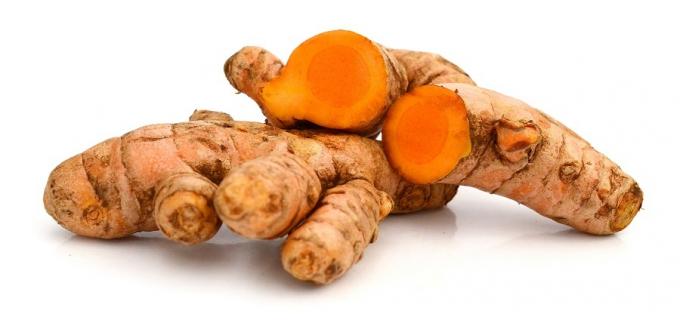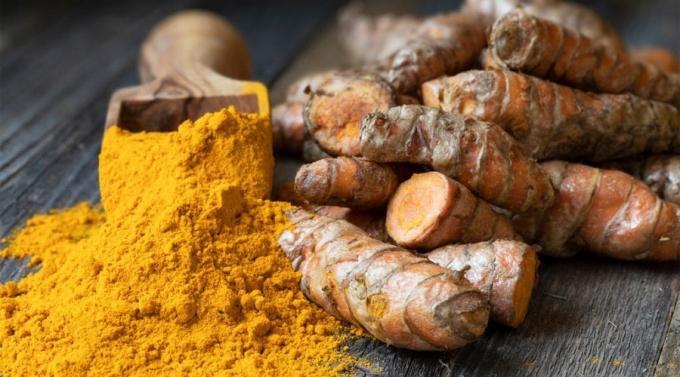Turmeric is a plant well known worldwide for its medicinal properties and culinary use. It is also called turmeric, turmeric, saffron, saffron, mangarataia and golden ginger. Known in the international market as turmeric, turmeric is also used in perfumery and textiles.
Read too: What are herbal medicines?
→ Turmeric characteristics
Turmeric (long curcuma) is a plant of the Zingiberaceae family, the same family as ginger. Originally from India and Southeast Asia, this plant is often confused with theCrocus sativus, which is also known as saffron or true saffron..
The confusion lies in the fact that the two plants have the property of pigmenting the color yellow, however, the real saffron has a more intense aroma and a more vibrant color. In addition, real saffron is highly valued, with a value of around 70 reais per gram.

Turmeric is a herbaceous and perennial plant.
Turmeric is a herbaceous and perennial plant (leaves do not fall) and reaches about 150 centimeters in height. Its leaves are large, long and, when crushed, release a characteristic odor.
This plant has a rhizome (type of stalk), portion of great economic interest. This structure is rich in curcumin dye and essential oils and has a reddish yellow color. Its flowers are yellow or white, have a pleasant smell and are arranged in an ear.
Turmeric is reproduced through rhizomes (vegetative propagation). Usually, a newly sprouted rhizome is placed in the pit. This plant was introduced in Brazil in the 80's and is widely cultivated in tropical and subtropical regions.
→ Turmeric Benefits
Turmeric is a medicinal plant traditionally used in Ayurvedic medicine (a medicine developed in India) for about six thousand years. It is indicated for problems such as colds, sinusitis, bacterial infections, liver changes, diabetes, injuries, anorexia and rheumatism.

Turmeric rhizome has important active principles beneficial to health.
It is currently known that turmeric has a number of important pharmacological properties. Among them, the actions stand out:
antioxidant;
anti-inflammatory;
antibacterial;
antidiarrheal;
anti-scurvy;
antispasmodic;
antifungal;
antiparasitic;
antitumor;
antiviral;
diuretics;
hepatoprotective;
neuroprotective;
lowering cholesterol levels;
sedative.
Some works also suggest that turmeric presents neuroprotective effects in the treatment of Parkinson's and Alzheimer's disease, as well as helping to fight some types of cancer. However, research is still being carried out in order to confirm these effects and analyze the appropriate doses.
→ How to use turmeric?

Turmeric can be used in different ways.
Turmeric can be used in different ways and can be used to treat various health problems.
Some ways to use this plant are: decoction (boiling) of the rhizome, infusion, tincture (type of preparation in which if alcohol and a certain medicinal plant are used), micronized powder, dry extract, standardized extract and extract fluid. The recommended form of use will depend on each treatment.
Read too:What is natural doesn't hurt?
Let's not forget that turmeric is used as a condiment, it can be used, for example, in sauces, red and white meat, rice and broths. Turmeric flavor is slightly spicy.
→ Contraindications to the use of turmeric
Turmeric is a product that has low toxicity, causing no damage when used in doses of up to 10 g/day. Although it does not cause great damage, the use of turmeric presents some contraindications.
people who own gastric ulcers or who have a history of the problem should not make prolonged use of turmeric. Also, people who present sensitivity or allergy to curcumin, obstruction of the bile ducts, bleeding disorders or using drugs that alter the clotting process should not use turmeric.
As it can also induce abortion, turmeric should not be used by pregnant women. Its use is also not suitable for infants and children.
Read too: Risks of using buchinha-do-norte as an abortifacient

Turmeric should not be used by pregnant women.
In addition to contraindications, it is important to be aware of the drug interactions. Because it has anticoagulant activity, the use of turmeric together with anticoagulants, for example, can lead to bleeding. In addition, it interacts with some anti-inflammatory drugs, immunosuppressants and medications, such as irinotecan and cotrimoxazole.
Thus, it is important to always analyze the drugs being used before using turmeric or any other medication. This information can be seen in the medicine package insert.
ATTENTION:Do not use any product without first consulting a physician. Although turmeric is natural, its ingestion in inadequate amounts can damage health and even harm the treatment of other diseases.
By Me. Vanessa Sardinha
